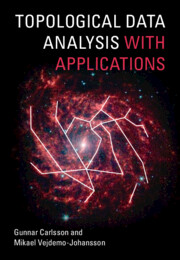Refine search
Actions for selected content:
1835 results in Knowledge Management, Databases and Data Mining
Part I - Background
-
- Book:
- Topological Data Analysis with Applications
- Published online:
- 25 November 2021
- Print publication:
- 16 December 2021, pp 1-2
-
- Chapter
- Export citation
5 - Structures on Spaces of Barcodes
- from Part II - Theory
-
- Book:
- Topological Data Analysis with Applications
- Published online:
- 25 November 2021
- Print publication:
- 16 December 2021, pp 145-156
-
- Chapter
- Export citation
6 - Case Studies
- from Part III - Practice
-
- Book:
- Topological Data Analysis with Applications
- Published online:
- 25 November 2021
- Print publication:
- 16 December 2021, pp 159-206
-
- Chapter
- Export citation
Contents
-
- Book:
- Topological Data Analysis with Applications
- Published online:
- 25 November 2021
- Print publication:
- 16 December 2021, pp v-vi
-
- Chapter
- Export citation
Index
-
- Book:
- Topological Data Analysis with Applications
- Published online:
- 25 November 2021
- Print publication:
- 16 December 2021, pp 216-220
-
- Chapter
- Export citation
1 - Introduction
- from Part I - Background
-
- Book:
- Topological Data Analysis with Applications
- Published online:
- 25 November 2021
- Print publication:
- 16 December 2021, pp 3-10
-
- Chapter
- Export citation
4 - Shape of Data
- from Part II - Theory
-
- Book:
- Topological Data Analysis with Applications
- Published online:
- 25 November 2021
- Print publication:
- 16 December 2021, pp 94-144
-
- Chapter
- Export citation
2 - Data
- from Part I - Background
-
- Book:
- Topological Data Analysis with Applications
- Published online:
- 25 November 2021
- Print publication:
- 16 December 2021, pp 11-26
-
- Chapter
- Export citation
3 - Topology
- from Part II - Theory
-
- Book:
- Topological Data Analysis with Applications
- Published online:
- 25 November 2021
- Print publication:
- 16 December 2021, pp 29-93
-
- Chapter
- Export citation
Part II - Theory
-
- Book:
- Topological Data Analysis with Applications
- Published online:
- 25 November 2021
- Print publication:
- 16 December 2021, pp 27-28
-
- Chapter
- Export citation
Part III - Practice
-
- Book:
- Topological Data Analysis with Applications
- Published online:
- 25 November 2021
- Print publication:
- 16 December 2021, pp 157-158
-
- Chapter
- Export citation

Topological Data Analysis with Applications
-
- Published online:
- 25 November 2021
- Print publication:
- 16 December 2021
13 - Dynamic Chinese Restaurant Game: Sequential Decision-Making in Dynamic Systems
- from Part III - Sequential Decision-Making
-
- Book:
- Reciprocity, Evolution, and Decision Games in Network and Data Science
- Published online:
- 01 July 2021
- Print publication:
- 22 July 2021, pp 281-309
-
- Chapter
- Export citation
6 - Evolutionary Game for Cooperative Peer-to-Peer Streaming
- from Part II - Evolutionary Games
-
- Book:
- Reciprocity, Evolution, and Decision Games in Network and Data Science
- Published online:
- 01 July 2021
- Print publication:
- 22 July 2021, pp 109-130
-
- Chapter
- Export citation
Part II - Evolutionary Games
-
- Book:
- Reciprocity, Evolution, and Decision Games in Network and Data Science
- Published online:
- 01 July 2021
- Print publication:
- 22 July 2021, pp 107-108
-
- Chapter
- Export citation
Contents
-
- Book:
- Reciprocity, Evolution, and Decision Games in Network and Data Science
- Published online:
- 01 July 2021
- Print publication:
- 22 July 2021, pp v-xii
-
- Chapter
- Export citation
2 - Indirect Reciprocity Game in Cognitive Networks
- from Part I - Indirect Reciprocity
-
- Book:
- Reciprocity, Evolution, and Decision Games in Network and Data Science
- Published online:
- 01 July 2021
- Print publication:
- 22 July 2021, pp 9-27
-
- Chapter
- Export citation
11 - Introduction to Sequential Decision-Making
- from Part III - Sequential Decision-Making
-
- Book:
- Reciprocity, Evolution, and Decision Games in Network and Data Science
- Published online:
- 01 July 2021
- Print publication:
- 22 July 2021, pp 249-252
-
- Chapter
- Export citation
Part I - Indirect Reciprocity
-
- Book:
- Reciprocity, Evolution, and Decision Games in Network and Data Science
- Published online:
- 01 July 2021
- Print publication:
- 22 July 2021, pp 7-8
-
- Chapter
- Export citation
4 - Multiuser Indirect Reciprocity Game for Cooperative Communications
- from Part I - Indirect Reciprocity
-
- Book:
- Reciprocity, Evolution, and Decision Games in Network and Data Science
- Published online:
- 01 July 2021
- Print publication:
- 22 July 2021, pp 55-79
-
- Chapter
- Export citation
